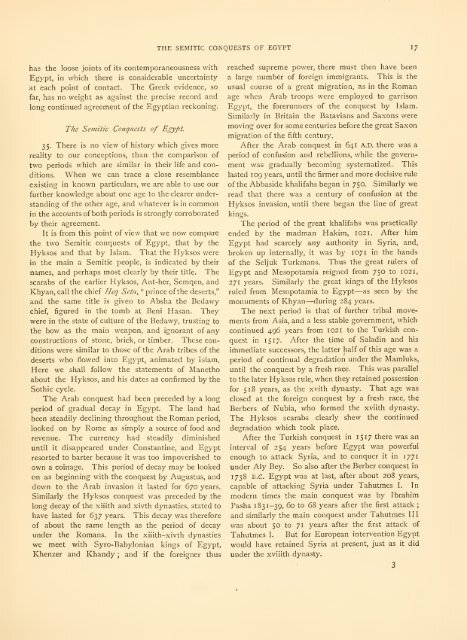Historical studies
Historical studies
Historical studies
You also want an ePaper? Increase the reach of your titles
YUMPU automatically turns print PDFs into web optimized ePapers that Google loves.
has the loose joints of its contemporaneousness with<br />
Egypt, in which there is considerable uncertainty<br />
at each point of contact. The Greek evidence, so<br />
far, has no weight as against the precise record and<br />
long continued agreement of the Egyptian reckoning.<br />
Tlie Semitic Conquests of Egypt.<br />
35. There is no view of history which gives more<br />
reality to our conceptions, than the comparison of<br />
two periods which are similar in their life and con-<br />
ditions. When we can trace a close resemblance<br />
existing in known particulars, we are able to use our<br />
further knowledge about one age to the clearer understanding<br />
of the other age, and whatever is in common<br />
in the accounts of both periods is strongly corroborated<br />
by their agreement.<br />
It is from this point of view that we now compare<br />
the two Semitic conquests of Egypt, that by the<br />
Hyksos and that by Islam. That the Hyksos were<br />
in the main a Semitic people, is indicated by their<br />
names, and perhaps most clearly by their title. The<br />
scarabs of the earlier Hyksos, Ant-her, Semqen, and<br />
Khyan, call the chief Heq Setu, " prince of the deserts,"<br />
and the same title is given to Absha the Bedawy<br />
chief, figured in the tomb at Beni Hasan. They<br />
were in the state of culture of the Bedawy, trusting to<br />
the bow as the main weapon, and ignorant of any<br />
constructions of stone, brick, or timber. These con-<br />
ditions were similar to those of the Arab tribes of the<br />
deserts who flowed into Egypt, animated by Islam.<br />
Here we shall follow the statements of Manetho<br />
about the Hyksos, and his dates as confirmed by the<br />
Sothic cycle.<br />
The Arab conquest had been preceded by a long<br />
period of gradual decay in Egypt. The land had<br />
been steadily declining throughout the Roman period,<br />
looked on by Rome as simply a source of food and<br />
revenue. The currency had steadily diminished<br />
until it disappeared under Constantine, and Egypt<br />
resorted to barter because it was too impoverished to<br />
own a coinage. This period of decay may be looked<br />
on as beginning with the conquest by Augustus, and<br />
down to the Arab invasion it lasted for 670 years.<br />
Similarly the Hyksos conquest was preceded by the<br />
long decay of the xiiith and xivth dynasties, stated to<br />
have lasted for 637 years. This decay was therefore<br />
of about the same length as the period of decay<br />
under the Romans. In the xiiith-xivth dynasties<br />
we meet with Syro-Babylonian kings of Egypt,<br />
Khenzer and Khandy ; and if the foreigner thus<br />
THE SEMITIC CONQUESTS OF EGYPT 17<br />
reached supreme power, there must then have been<br />
a large number of foreign immigrants. This is the<br />
usual course of a great migration, as in the Roman<br />
age when Arab troops were employed to garrison<br />
Egypt, the forerunners of the conquest by Islam.<br />
Similarly in Britain the Batavians and Saxons were<br />
moving over for some centuries before the great Saxon<br />
migration of the fifth century.<br />
After the Arab conquest in 641 A.D. there was a<br />
period of confusion and rebellions, while the government<br />
was gradually becoming systematized. This<br />
lasted 109 years, until the firmer and more decisive rule<br />
of the Abbaside khalifahs began in 750. Similarly we<br />
read that there was a century of confusion at the<br />
Hyksos invasion, until there began the line of great<br />
kings.<br />
The period of the great khalifahs was practically<br />
ended by the madman Hakim, 102 1. After him<br />
Egypt had scarcely any authority in Syria, and,<br />
broken up internally, it was by 107 1 in the hands<br />
of the Seljuk Turkmans. Thus the great rulers of<br />
Egypt and Mesopotamia reigned from 750 to 1021,<br />
271 years. Similarly the great kings of the Hyksos<br />
ruled from Mesopotamia to Egypt—as seen by the<br />
monuments of Khyan—during 284 years.<br />
The next period is that of further tribal movements<br />
from Asia, and a less stable government, which<br />
continued 496 years from 1021 to the Turkish con-<br />
quest in 1517. After the time of Saladin and his<br />
irhmediate successors, the latter half of this age was a<br />
period of continual degradation under the Mamluks,<br />
until the conquest by a fresh race. This was parallel<br />
to the later Hyksos rule, when they retained possession<br />
for 518 years, as the xvith dynasty. That age was<br />
closed at the foreign conquest by a fresh race, the<br />
Berbers of Nubia, who formed the xviith dynasty.<br />
The Hyksos scarabs clearly shew the continued<br />
degradation which took place.<br />
After the Turkish conquest in 15 17 there was an<br />
interval of 254 years before Egypt was powerful<br />
enough to attack Syria, and to conquer it in 1771<br />
under Aly Bey. So also after the Berber conquest in<br />
1738 B.C. Egypt was at last, after about 208 years,<br />
capable of attacking Syria under Tahutmes I. In<br />
modern times the main conquest was by Ibrahim<br />
Pasha 1831-39, 60 to 68 years after the first attack ;<br />
and similarly the main conquest under Tahutmes HI<br />
was about 50 to 71 years after the first attack of<br />
Tahutmes I. But for European intervention Egypt<br />
would have retained Syria at present, just as it did<br />
under the xviiith dynasty.

















